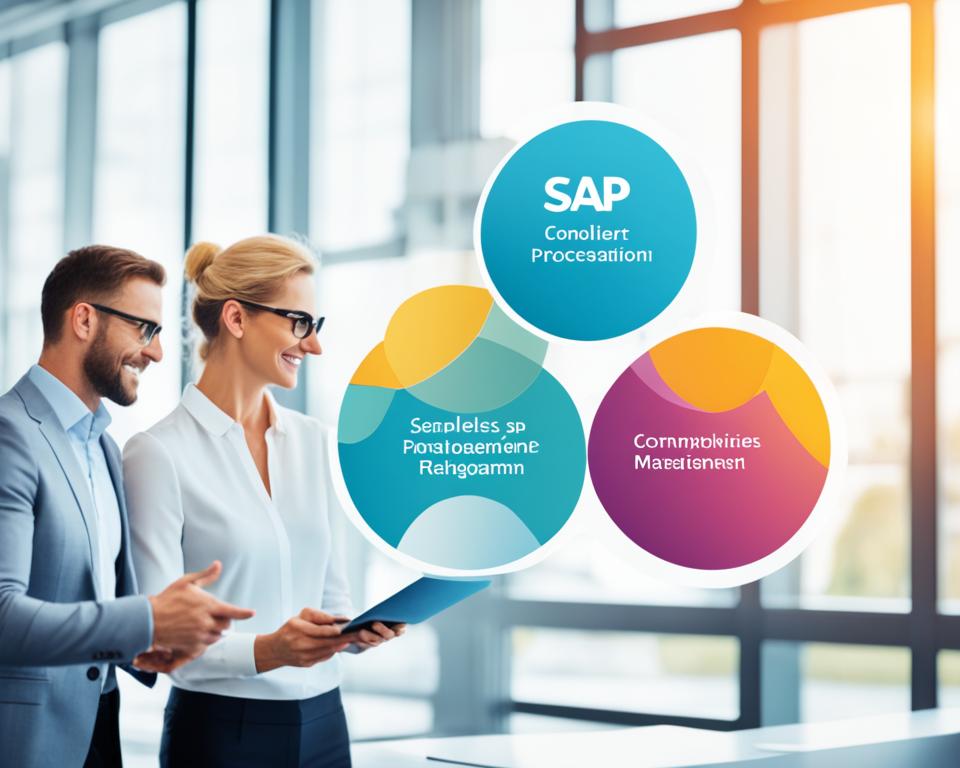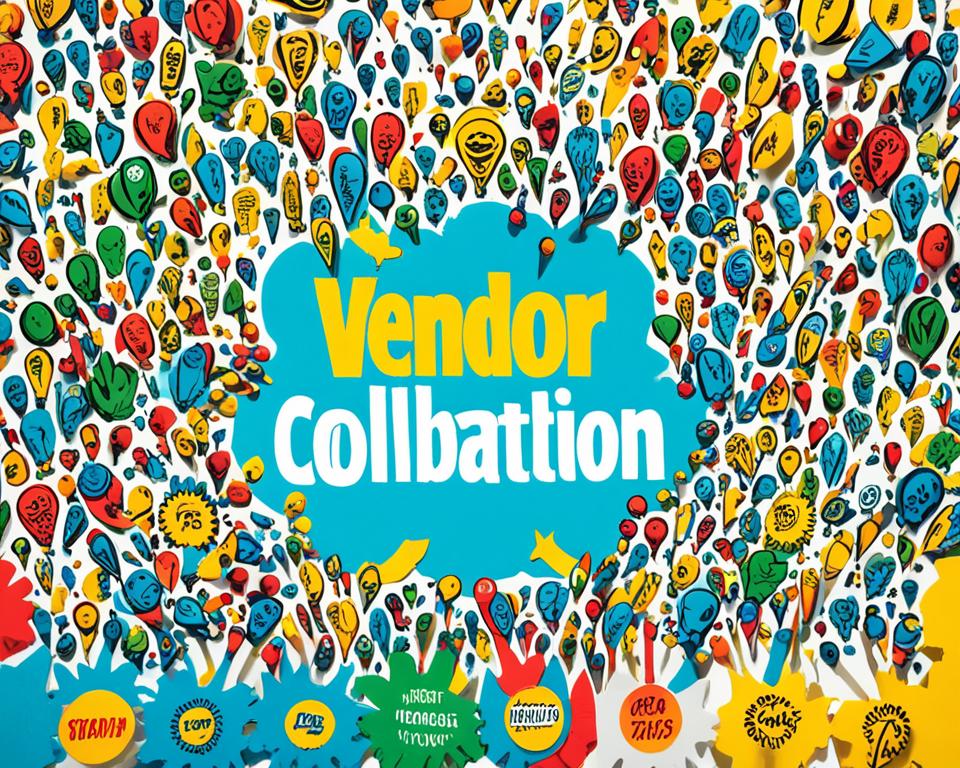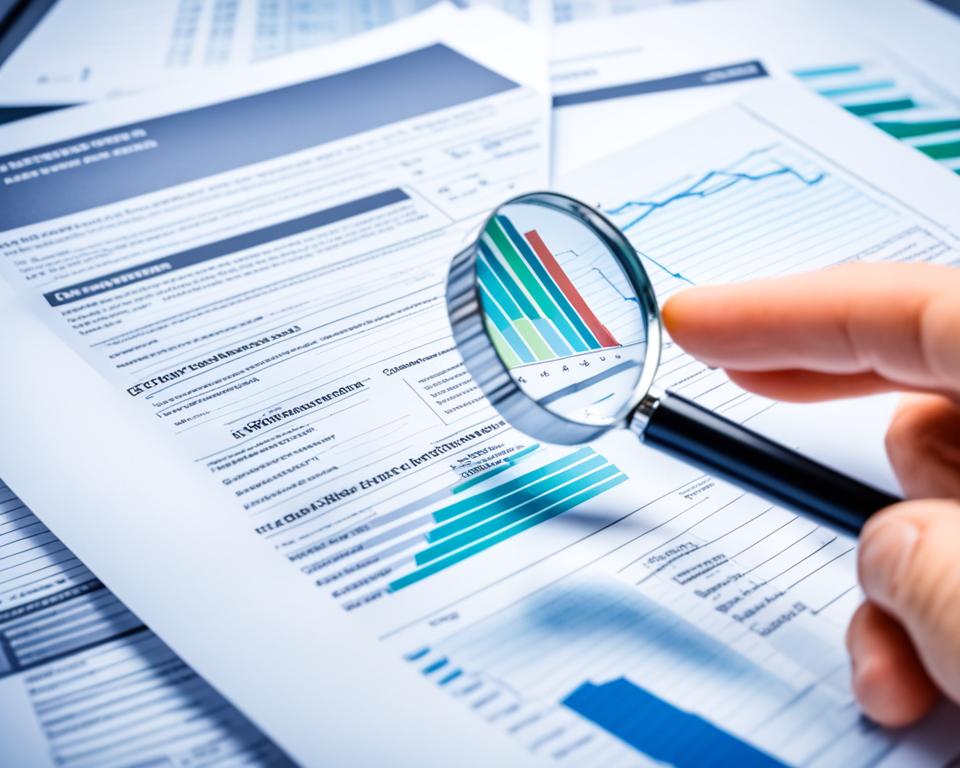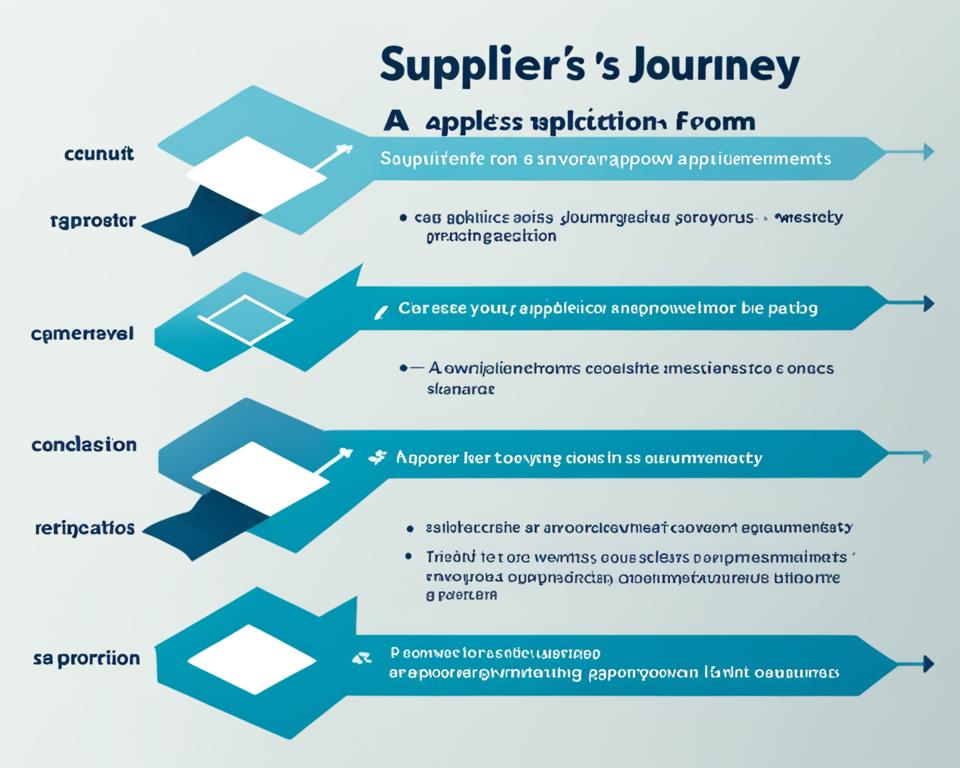Ever thought about how working better with suppliers could boost your business? In today’s fast market, knowing about SAP Supplier Relationship Management (SAP SR) is key. It helps improve how you buy things and work with suppliers. This article will look closely at SAP SR and its big role in making better sourcing and procurement strategies.
Experts share insights on how SAP SR can make your supply chain more efficient and productive. It changes how businesses work with their suppliers, creating a strong and effective partnership. For more on SAP and ABAP, check out this resource.
Key Takeaways
- Understanding SAP SR enhances supplier collaboration.
- Effective procurement management drives operational efficiency.
- SAP SR facilitates strategic sourcing initiatives.
- Collaboration with suppliers leads to improved performance.
- Utilizing technology can streamline procurement processes.
- Success in procurement management aligns with supplier relationship strategies.
Understanding Supplier Relationship Management
Supplier Relationship Management (SRM) starts with key elements. It’s about managing supplier interactions for better relationships. SRM is vital for mutual benefits and improving how an organization works with its suppliers.
Definition and Importance
SRM uses practices and frameworks to manage supplier interactions well. It’s key for better procurement, driving innovation, and improving supplier collaboration. A strong SRM strategy helps manage suppliers from start to finish, leading to ongoing improvements and less risk.
The Role of SRM in Procurement
In procurement, SRM is very important. It offers a structured way to work with suppliers at every stage. Good SRM in procurement means better communication, more efficiency, and cost savings. Companies like SAP use SAP Ariba to improve supplier interactions and streamline procurement.
| Key Aspects of SRM | Benefits |
|---|---|
| Enhanced Supplier Collaboration | Stronger partnerships lead to better service and value. |
| Increased Procurement Efficiency | Streamlined processes save time and resources. |
| Risk Reduction | Ongoing assessments lower the chance of supply chain disruptions. |
| Innovation Promotion | Collaboration fosters creativity and new solutions. |
Key Features of SAP SR
SAP SR has many key features that make managing supplier relationships better. It helps organizations make their procurement processes more efficient. This leads to better overall efficiency.
Integration with Existing Systems
SAP SR works well with other systems you already use. This means data stays consistent across all platforms. It cuts down on errors and makes work flow better.
It connects with systems like Enterprise Resource Planning (ERP) and Customer Relationship Management (CRM). This gives a clear view of supplier info. It helps make better decisions.
User-Friendly Interface
The interface of SAP SR is easy for people of all skill levels. It’s designed to be simple to use, making it easy to find what you need. This makes users more engaged and helps them use the software fully.
This leads to better productivity in managing suppliers.
Customizable Dashboards
Customizable dashboards are a big plus of SAP SR. Companies can set up dashboards to show the data they need. This lets decision-makers see important info clearly.
It helps them make decisions based on data. This strategy matches business goals.

Benefits of Implementing SAP SR
Implementing SAP SR is a game-changer for businesses wanting to improve their supplier relationships and procurement. It brings a host of benefits, from better vendor collaboration to more efficient strategic sourcing.
Enhanced Vendor Collaboration
The benefits of SAP SR include better vendor collaboration. This system helps build stronger partnerships between companies and their suppliers. It leads to clearer communication and more shared information.
Things like inventory levels, production schedules, and market trends are easier to share. This teamwork ensures everyone’s goals are in line.
Improved Supply Chain Optimization
Using SAP SR also boosts supply chain optimization. It offers advanced analytics and real-time data. This means companies can see their supply chains clearly and make quick changes to meet demand.
By fixing problems early, companies stay efficient and avoid delays in delivering products.
Increased Efficiency in Strategic Sourcing
SAP SR also makes strategic sourcing more efficient. It gives insights into how suppliers perform and what the market is like. This helps businesses make smart buying choices.
This smart approach saves money and boosts overall performance. It leads to better use of resources and picking the right suppliers.
Vendor Collaboration Strategies
Working together with vendors is key to building strong partnerships that help everyone. I’ve learned that focusing on long-term partnerships leads to better results in buying and selling. Trust and understanding are the foundation of successful partnerships.
Developing Strong Supplier Partnerships
To create strong partnerships, it’s important to know each other’s goals and strengths. Sharing information and ideas leads to new solutions and a competitive edge. Here are ways to build these partnerships:
- Regular meetings to check on progress and set goals together.
- Working together to solve problems.
- Being open about how well things are going and business plans.
Effective Communication Techniques
Good communication makes supplier relationships work better by keeping everyone on the same page. Keeping the lines of communication open helps everything run smoothly. Here are some effective ways to communicate:
- Clear meeting agendas to stay focused.
- Using technology for quick teamwork and feedback.
- Talking openly and listening well to build respect and understanding.
Using these strategies improves supplier partnerships and makes the supply chain stronger and more flexible.

Streamlining Procurement Management
Efficient procurement management boosts an organization’s performance and cuts costs. By using best practices, businesses can make their procurement better. This leads to better results and a strategic edge in the market.
Best Practices for Procurement Processes
To make procurement smooth, I suggest following best practices. These include:
- Standardizing procurement processes for consistency.
- Using templates for common transactions to save time.
- Engaging in strategic sourcing to find the best suppliers.
- Encouraging supplier collaboration for better relationships.
These steps help streamline operations and boost procurement management.
Leveraging Technology for Procurement Efficiency
Using technology in procurement is key to improving processes. Tools like SAP Ariba automate tasks, provide real-time data, and offer analytics. These technologies make procurement more efficient and adaptable to changes in the market.
Organizations can learn more about these tools by visiting this resource. It offers insights on using technology effectively.
Insights into Contract Management
Effective contract management is key to a strong supplier relationship. It sets the rules and is vital throughout the contract’s life. Contract Lifecycle Management (CLM) includes negotiation, execution, and monitoring contracts. This helps with following rules and managing risks at every stage. A strong contract management approach helps in working well with suppliers.
Contract Lifecycle Management
The contract lifecycle has many stages, each needing careful attention. These stages are:
- Negotiation and drafting
- Approval and execution
- Performance monitoring
- Renewal or termination
This full view of the contract lifecycle helps organizations spot and fix problems early. It makes working with suppliers better.
Key Elements of a Successful Contract Strategy
A good contract strategy has a few key parts. These parts shape how contracts are managed. The main elements are:
- Clarity in terms and conditions – Making sure everyone knows what’s expected helps avoid confusion.
- Performance metrics – Setting clear goals helps check how well suppliers are doing.
- Monitoring mechanisms – Using tools to track how well things are going is key to avoiding risks.
By focusing on these elements, I’ve seen companies protect their interests and build strong supplier relationships. For more tips on improving contract management, check out integrating advanced solutions to make things smoother.

Evaluating Supplier Performance
Evaluating how well suppliers do their job is key to meeting quality and service standards. A good way to do this is by setting clear goals. These goals help us see how well suppliers are doing and where they can get better. It also helps us work better with our suppliers.
Defining Key Performance Indicators (KPIs)
KPIs help us check how well suppliers are doing. Important metrics include:
- Delivery Time: How fast they send out shipments.
- Quality Metrics: How well their products match what we need.
- Response Rates: How quick they answer our questions or fix problems.
- Cost Management: How their prices stack up against others and their past performance.
By looking at these KPIs, I can really understand how good suppliers are. This helps me make smart choices to improve our relationship with them.
Continuous Improvement Initiatives
It’s important to always look for ways to get better. Working together with suppliers helps us find new ways to innovate and do better. Here are some ways we can keep getting better:
- Have regular meetings with suppliers to set new goals.
- Use feedback from both sides to learn and improve.
- Offer training programs to help everyone get better.
- Use technology to share data quickly and be open.
These steps help us keep getting better and manage our suppliers in a smart way. By always looking to improve, we can make our supplier relationships stronger and more successful.
| KPIs | Importance | Monitoring Frequency |
|---|---|---|
| Delivery Time | Ensures reliable supply chain | Monthly |
| Quality Metrics | Maintains product integrity | Quarterly |
| Response Rates | Aids quick issue resolution | Bi-Weekly |
| Cost Management | Optimizes sourcing strategies | Annually |
Spend Analysis for Informed Decisions
Doing a deep dive into spend analysis helps companies understand their spending better. By looking at purchase data, they can spot trends that show where they can save money. This smart move helps with managing money better and improving how they buy things.
Identifying Cost-Saving Opportunities
It’s key to check vendor contracts and purchase orders closely to save money. Looking at past spending can uncover ways to save that are not obvious. By looking for discounts, talking about new terms, or working with fewer suppliers, big savings can be made.
Utilizing Data Analytics
Data analytics is crucial in turning spending data into useful insights. With advanced tools, companies can see how they spend in different areas. This helps in making better choices about who to work with, making sure they meet their goals.
| Analysis Category | Description | Potential Savings Strategies |
|---|---|---|
| Vendor Contracts | Review terms and conditions of existing contracts. | Renegotiate terms, seek volume discounts. |
| Purchase Orders | Examine order frequencies and quantities. | Consolidate orders, adjust quantities for savings. |
| Spending Patterns | Identify trends in procurement spending. | Switch suppliers, identify cheaper alternatives. |
Managing Supplier Risks Effectively
Managing risks with suppliers is key to keeping supply chains stable. Companies should use detailed risk checks to spot weak spots in their supplier network.
Risk Assessment Techniques
Using thorough risk checks helps businesses get to know their suppliers better. A good method is the SWOT analysis, which looks at Strengths, Weaknesses, Opportunities, and Threats. This helps spot risks and guide smart choices. Regular checks and reviews of supplier performance also help keep track of any changes.
Mitigation Strategies for Procurement Risks
After checking risks, companies can work on reducing them. Diversifying suppliers cuts down on the risk of relying too much on one supplier. Having backup plans is crucial for handling surprises. By keeping an eye on supplier relationships and adjusting to changes, businesses can stay strong and protect their supply chains.
Steps for Successful Supplier Onboarding
Creating a strong supplier onboarding process is key to building good vendor relationships. A clear onboarding plan helps everyone understand each other from the start. I’ll share important steps for a smooth onboarding.
Creating an Efficient Onboarding Process
Starting a smooth onboarding process means having clear rules and lots of training. Suppliers need the right materials and documents to feel confident in our systems. Using a platform like SAP Ariba helps keep communication clear throughout.
Engaging Suppliers from Day One
Getting suppliers involved right away boosts supplier engagement and builds a strong base. Welcome kits with important papers and contact info make suppliers feel important. Orientation sessions introduce the team, share goals, and help everyone understand each other better. Regular meetings early on solve problems and keep the team working together well. For more tips on improving this partnership, check out how Ariba Supplier Collaboration can streamline

| Onboarding Element | Description | Benefits |
|---|---|---|
| Guidelines | Clear instructions on expectations and responsibilities. | Increased clarity and reduced misunderstandings. |
| Training Resources | Access to materials for efficient system navigation. | Empowerment of suppliers to perform effectively. |
| Welcome Kits | Essentials for initial engagement. | Fosters a sense of belonging from the start. |
| Orientation Sessions | Interactive introduction of the teams and objectives. | Builds rapport and alignment on goals. |
| Regular Check-ins | Frequent updates and discussions about progress. | Ensures issues are addressed promptly. |
SAP SR – Revolutionizing Supplier Relationship Management
SAP SR is leading the way in changing how we manage supplier relationships. As the market changes, new innovations are key to this shift. Keeping an eye on future trends in SRM helps us stay ahead and work more efficiently. Using technologies like artificial intelligence and value-based sourcing makes working with suppliers better and improves our buying strategies.
Innovations and Future Trends
Organizations are now using tools that help us work better with suppliers. Some big changes include:
- Real-time performance tracking
- Automated compliance monitoring
- Enhanced data analytics capabilities
- Integration with digital platforms for seamless transaction management
These SAP SR innovations make things run smoother and help us make smart choices. This leads to better relationships with suppliers.
Real-World Success Stories
Many companies have shared stories of success with SAP SR. For example, a big manufacturing company cut their procurement costs by 30% after using the system. A global retail brand also saw better supplier satisfaction scores thanks to better communication and teamwork.
| Organization Type | Improvement Areas | Results |
|---|---|---|
| Manufacturing | Procurement Costs | 30% Reduction |
| Retail | Supplier Satisfaction | Increased Scores |
| Technology | Collaboration | Enhanced Communication |
These stories show how SAP SR innovations help companies get the most out of their supplier relationships. As things keep changing, focusing on good SRM is key for growth and success.
Common Challenges in Supplier Relationship Management
Organizations face big hurdles in managing supplier relationships. One big issue is getting stakeholders to accept new ways of doing things. They often stick to old methods they know well. To overcome these hurdles, it’s key to have a plan and make the switch to new practices smoothly.
Overcoming Resistance to Change
To get past resistance, it’s important to clearly explain why new methods and tools are better. Showing how they can make things more efficient and save money can help. Training and workshops can also help stakeholders see the value in new approaches and share stories of success.
Aligning Stakeholder Interests
Getting everyone on the same page is vital for strong supplier relationships. If priorities don’t match, it can cause problems. By involving stakeholders early, you build a sense of ownership and commitment. Regular feedback helps make sure everyone is working towards the same goals.

Using systems like SAP Ariba can help. Real-world success stories show how effective SRM strategies can lead to better outcomes. By focusing on practical use, businesses can overcome resistance and align stakeholders, building strong supplier partnerships.
Conclusion
SAP SR has changed the game in managing supplier relationships. It boosts collaboration, making things run smoother and more efficiently. This tool does more than just handle transactions. It helps build stronger ties and strategic partnerships with suppliers.
Working well with suppliers is an ongoing effort that needs constant innovation. This article highlights how good supplier management is key to reaching goals and staying ahead. Using technology and checking on supplier performance helps tackle today’s market challenges.
Looking back at the main points, it’s clear that using these strategies puts companies ahead. Being ahead in managing supplier relationships boosts operations and strengthens key partnerships. This leads to lasting growth.
FAQ
What is SAP SR and how does it relate to Supplier Relationship Management?
SAP SR, or SAP Supplier Relationship Management, is a solution that improves the bond between companies and their suppliers. It helps with better buying, strategic sourcing, and making supply chains more efficient. It does this by improving how suppliers work together and using insights for smarter decisions.
Why is Supplier Relationship Management important in procurement?
Supplier Relationship Management (SRM) is key because it helps companies and suppliers work together better. It makes buying more efficient, encourages new ideas, and sets a plan for managing suppliers at all stages of their relationship with the company.
What are the key features of SAP SR?
SAP SR has features like easy integration with current systems, a simple interface, and customizable dashboards. These help tailor views to fit the company’s needs. They make managing suppliers better and boost overall efficiency.
What benefits can organizations expect from implementing SAP SR?
With SAP SR, companies get better collaboration with vendors, improved supply chains, and more efficient sourcing. These lead to saving money and better performance through smarter buying and stronger supplier ties.
What strategies can enhance vendor collaboration?
To improve vendor collaboration, focus on building strong partnerships based on trust and mutual gain. Use good communication, like regular updates and feedback, to keep things clear and in line. This leads to lasting supplier partnerships.
How can procurement management be streamlined effectively?
Make procurement better by using best practices like standardizing processes and strategic sourcing. Technology like SAP SR can also help by automating tasks, giving real-time data, and offering detailed analytics.
What is involved in effective contract management?
Good contract management means having strong processes for managing contracts from start to finish. This includes negotiating, carrying out contracts, and keeping an eye on them. A good contract plan has clear terms, performance goals, and ways to check compliance and manage risks.
How do organizations evaluate supplier performance?
Checking how well suppliers do involves setting Key Performance Indicators (KPIs) for things like delivery time and quality. It’s also important to work with suppliers to improve their performance and bring in new ideas.
What is the significance of spend analysis in procurement?
Spend analysis helps companies look closely at their spending to make better choices. By finding ways to save money from contracts and spending patterns, companies can better manage their budgets and pick the best suppliers.
How can supplier risks be managed effectively?
Managing supplier risks means using risk assessment tools like SWOT analyses to spot and judge risks. It’s also key to have plans to reduce risks, such as having multiple suppliers and being ready for emergencies.
What are the steps for successful supplier onboarding?
Onboarding suppliers well means having a smooth process with clear rules, training, and good communication. Starting with suppliers early through orientation and regular meetings helps build a strong partnership.


